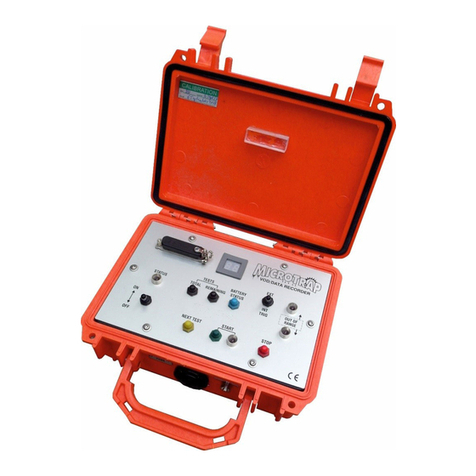
MicroTrap™ Operations Manual - Edition 4.4
6
The MicroTrap™ VOD/Data Recorder is a portable, 1 channel, high resolution, explosives continuous Velocity of Detonation (VOD)
recorder. It can be upgraded easily to provide an additional 4 channels of DC voltage (VDC) recording (Scope) capability. The operator
can use DAS™ Data Acquisition Suite Software to check if the unit has the Scope Upgrade installed during programming of the unit.
Contact MREL for MicroTrap™ VOD/Data Recorder Scope Upgrade information. This provides the MicroTrap™ VOD/Data Recorder with
the ability to record high resolution VODs of explosives and simultaneously record transient events such as blast vibrations, explosion
pressures, air blast, etc. at high resolutions. It has proven its reliability under the extreme temperature, weather, dust and rugged
conditions that characterize blasting environments around the world.
The DAS™ Data Acquisition Suite allows the User to analyze VOD traces and convert DC voltage signals recorded by the MicroTrap™
VOD/Data Recorder into the desired engineering units for analysis and presentation. The software is used to program the recording
parameters of the MicroTrap™ VOD/Data Recorder, and to retrieve, display, analyze, print, and export VOD or other sensor data
obtained through testing. The DAS™ Data Acquisition Suite Software runs under 32 or 64 bit Microsoft Windows®. This facilitates
extremely fast data handling, and the ability to copy and paste graphs into any word processors or spreadsheets running in the
Windows® environment. Refer to the DAS™ Data Acquisition Suite Software for more information.
The main features of the MicroTrap™ VOD/Data Recorder for VOD recording are:
• One VOD channel capable of recording at up to 2 MHz (2 million data points/sec). This speed provides a time resolution of one
data point for every 0.5 microseconds.
• Capability to record VODs and delay times using up to 900 m (2,950 ft.) of MREL’s PROBECABLE-LR VOD resistance cable. This
ensures that the MicroTrap™ can record the VODs and delay times in many blastholes per test.
• A large, circular, digital memory (4 million data points) to store the recorded data. This allows the MicroTrap™ VOD/Data Recorder
to record for relatively long periods (2.0 seconds) when recording at a rate of 2 MHz. The memory can be upgraded easily to
provide a total memory of 8 million data points. Contact MREL for MicroTrap™ Memory Upgrade information.
• A high, 14 bit vertical (or distance) resolution (214 or 1 part in 16,384). Use of shorter lengths of PROBECABLE-LR provides even more
data points recorded along every meter.
• Large non-volatile memory for storing up to 16 events before the data needs to be downloaded to a computer.
• Data is downloaded to the PC via the supplied USB cable.
• The MicroTrap™ VOD/Data Recorder can be upgraded easily to provide an additional 4 channels of DC voltage recording
capabilities at a recording rate of 1 MHz. Contact MREL for MicroTrap™ Scope Upgrade information.
• The status of the MicroTrap™ Memory and Scope Upgrade for each MicroTrap™ VOD/Data Recorder can be found when the unit is
connected to DAS™ Data Acquisition Suite Software. Please refer to the DAS™ Data Acquisition Suite Manual for the location of this
information for each unit.
2.1 Background
This Chapter provides an introduction to the MicroTrap™ VOD/Data Recorder.
Overview





























